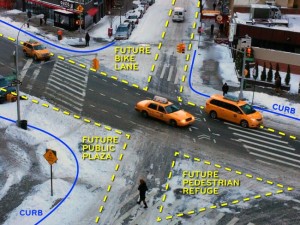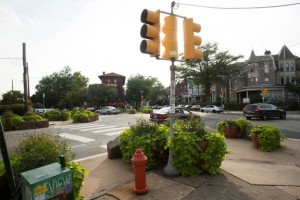
As cycle advocates, we know that intersections are the most dangerous part of the roading network for all users and we are often saying that too much street space is given over to cars. We also try and point out the benefits of a street scape that encourages walking and cycling while also creating pleasant public spaces.
However, it is often hard for people to visualise what that means and how much space cars actually take up in the current designs.
A phenomenon that has become increasingly discussed in the United States is where the recent heavy snow falls have narrowed streets and created bulb outs. This has both illustrated the road space that cars need when driving at safe speeds and shown how safe speeds can be achieved by road design – a virtuous circle of street design.

These snowy neckdowns or “sneckdowns” have captured worldwide attention. In particular the sneckdowns have shown how pedestrian bulb outs would slow turning speeds for cars while reducing the distance for pedestrians to cross the street.
Now we don’t (fortunately, in my opinion) get snow in Auckland. However, I did see a reference to an Australian study (I couldn’t find the reference sorry) where the researchers scattered flour on a street and then took photos of the street as the flour was slowly scattered by cars. The experiment again illustrated how cars don’t use all the road space allocated to them and how easy it would be to create a more pleasant street environment.
In Auckland, instead of bulb outs we have slip lanes. These are safer and faster for only one mode, motor vehicles. For everyone else it becomes a game of frogger where the penalty for failure or error is death or injury. What fun!
To change this, undoubtedly AT will need to engage a team of consultants and “experts” to study (ad nauseum) whether these intuitively sensible and effective changes should be implemented. Then they will apply their only tool for assessing streets, the almighty (mono-modal) LEVEL OF SERVICE, and decide (unsurprisingly) that this can’t happen because it will slow cars down. Exactly what it is intended to do.

However, in crazy, radical hippy communes like… Philadelphia and New York, they are just getting on and trying the new designs out. The traffic calming design on the right was instituted in Philadelphia directly based on sneckdowns. It is fast, temporary and even my non-traffic engineering brain-washed trained eye can see that this radically improves the design for pedestrians and cyclists.
Come on AT – get out there and make some changes. Repeat after me – fast, cheap, temporary. Now 1,000 times on the board.



